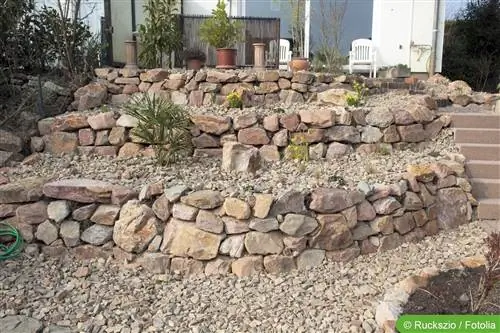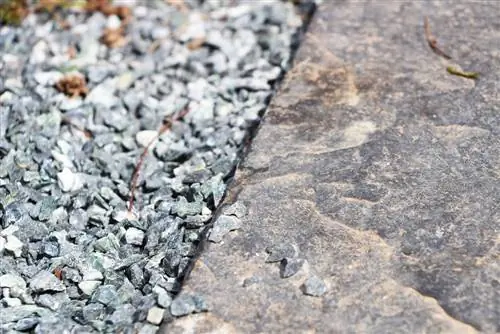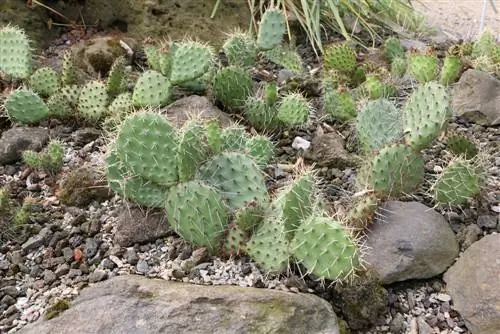- Author admin [email protected].
- Public 2023-12-17 03:39.
- Last modified 2025-06-01 06:48.
A rock garden is an alpine landscape only in a smaller version. Gardens on so-called hillsides are particularly suitable for a rock garden. This makes the plants stand out even better. But a rock garden is of course a real eye-catcher even without a hanging garden. Small elevations can be built here with earth embankments.
The right location
The ideal location for a rock garden is a slope. In addition, mountain plants that are used to permeable, humus-poor and stony soils are often used in a rock garden. In addition, the water can drain away immediately, which ensures optimal site conditions. Nevertheless, a slight movement in the terrain is usually enough.
The selection of stones
As the name suggests, the stones naturally play a major role in the rock garden. You have the freedom to choose between many different sizes. However, you should always embed the stones in the ground if they are larger, as it looks more natural. Two main factors play an important role in the choice of stones, namely the different rock shapes and the types of rock. When laying the stones, care should also be taken to ensure that they do not simply lie next to each other in an orderly manner. This quickly looks boring and unnatural. It is ideal if they are mixed and arranged one on top of the other. It is also possible to create small slopes or caves, which makes the overall picture appear even more interesting.
Create the rock garden
If possible, large stones should be used for the rock garden and small stones should not be used at all. You should then proceed as follows:
- The basic framework is created with large boundary stones. This also determines how big the rock garden should be.
- Now the remaining stones can be grouped into the rock garden. But don't place the stones regularly on the surface, it looks unnatural.
- Afterwards, transitions can be created with a few stones. Transitions can also be created with upholstery perennials or grasses.
The different elements
Many people will be familiar with dry stone walls. The natural stones are simply layered on top of each other to form a wall. The gaps are then planted with stone garden plants. These walls provide a pleasant habitat for many reptiles. In addition to the wall, raised beds made of stones can be built, as well as artificial mountains and ravines. An important factor here is always the size of the garden. Such systems can quickly seem a bit cluttered in small gardens. After all, the point of a rock garden is to mimic nature as closely as possible.
Water in the rock garden
This area should also appear lifelike. For example, a spring from which a small trickle forms and flows delicately is ideal. Another option is a small waterfall that cascades over stones. To make it look as close to nature as possible, you should use nature as a model and think about how this can best be implemented artificially.
Rock garden and plants
Of course, plants are absolutely necessary in a rock garden. They provide color and variety. However, these color spots should be used sparingly, otherwise the garden can quickly appear too kitschy and colorful. Several plants in the same color and in one place are ideal. For example, flowering or moss-like upholstery perennials go perfectly with the rock garden. The moss-like cushion perennials include woolly thyme, star moss, cushion knotweed, bearskin fescue or hedgehog cushion. The flowering variant includes moss saxifrage, sedum, hornwort, gentian, cushion phlox, cushion carnation, candytufts and carpet gypsophila. Japanese azaleas or boxwood balls can be planted in places where there are no stones. Onion flowers in the shape of squill or snow shine also fit well in a rock garden. Another important design element is woody plants. These should also be used sparingly. In addition, only weakly growing plants should be used, as they come closest to nature. For example, dwarf mountain pine, dwarf conifers or corkscrew willow are ideal.
Design ideas - the Japanese rock garden
The Japanese rock garden is particularly popular. However, it is very elaborately laid out with plants, stones and trees. According to Japanese tradition, it is intended to serve as a place of mediation and peace. In addition to the elements gravel, sand and stones, water is also one of the most important elements. This type of rock garden also requires very precise planning. It is also extremely complicated and has to be built according to certain rules.
The gravel garden
Grabble gardens are also very popular in rock gardens. This species is particularly characterized by its large variety of plants. In addition, creating a gravel garden is particularly suitable in sunny places. When planting, you should make sure that it is done randomly so that you don't suspect a system behind it. Larger distances and gaps between the plants are therefore definitely desirable. This gives the gravel a very interesting effect.
The herb garden
You can also plant a rock garden with many different spice plants. This is how you can fulfill your dream of having a herb garden. However, in order for optimal greenery to be achieved, the needs of the plants should definitely be taken into account. Many herbs from the south can thrive perfectly in sunny places. Local herbs prefer shady places.
Perennials for the rock garden
Perennials are best suited for a rock garden because they have ideal living conditions there. The needs of the plants should also be taken into account here. For example, cushion phlox, sedum and peony require a lot of warmth and light, as well as well-drained soil. In addition, the rock should be heat-retaining. Then there are perennials that prefer shade. But all rock garden perennials have one thing in common. They are so-called weak feeders, which means that small amounts of fertilizer are sufficient. Some perennials don’t even need to be fertilized.
How much space does a rock garden need?
A rock garden should always be created on a small slope in the garden, because this is the only way the rock garden and the plants in it can work properly. When it comes to the space required, it would of course be better if at least 10 square meters of slope were available, because then you can also plant larger plants such as dwarf broom and low pines. Often, particularly small rock gardens of 1-1.5 m wide look beautiful on the edges of paths or on the edge of the terrace.
Use the right stones
No matter how you want to design your rock garden; You should basically pay attention to two factors:
- Do not use different types of rock
- Do not use different rock shapes
The size of the stones should depend on the size of the garden. However, it creates a more beautiful picture if you use stones that are as large as possible. Whether square or round is basically a matter of taste. If you want to integrate a stream, you should use round stones if possible, while a typical rock garden usually consists of naturally angular stones.
Popular plants in the rock garden
- Alpine plants such as primroses, avocado, houseleek, gentian, carnation, houseleek and heath clove.
- low trees such as dwarf conifers and crabgrass
- colorful subshrubs for sunny locations: blue rue, lavender and thyme
- Subshrubs for cool locations: barberry, ferns and cherry laurel
Imaginative and interesting
So that you don't get bored at first glance at the rock garden, you should always try to make the rock garden interesting and imaginative. If possible, the stones should not be arranged one on top of the other, but rather mixed together and overlapping. You can also create small caves or slopes that later provide an ideal place for ground cover plants.
Other interesting garden forms are the Japanese garden and the herb garden.
General tips for creating a rock garden
- A rock garden should not appear too cluttered. Less is often more.
- You don't plant a rock garden under trees. Lots of leaves are bad for a rock garden and heavy stones are bad for the roots underneath.
- You first put out the stones and wait until they have settled before planting.
- Set accents. Either use topiary trees or those that stand out with their special colors (colored bark or evergreen leaves).
- Stones from quarries in the region are usually the cheapest to get.
- What is important about a rock garden is its natural effect.
- Burn large stones partially or halfway, this looks more natural.
- The potting soil must be well-drained.
- Rock garden plants need plenty of water during the growing phase. Later they get by with very little water and hardly need to be watered.
- They also hardly need fertilizer: they usually come from nutrient-poor areas. Adding compost in the spring is usually sufficient.
Conclusion of the editors
Creating a rock garden is not really difficult. A natural, not too steep slope is favorable. However, you can easily pile one up or create a hill in the garden. It is important not to use too many different types of rock. A rock garden works best if only one type is used, but stones in different sizes and shapes. When choosing plants, you should also limit yourself to a few varieties. Evergreen plants are important so that the garden does not look desolate in winter. Small needle plants with an unusual shape are favorable. If you have no ideas at all, you should take a look at the gardens in your neighborhood and get inspired there.






